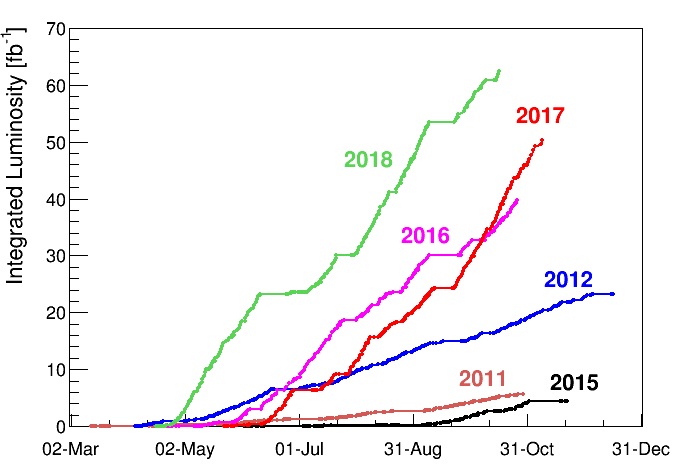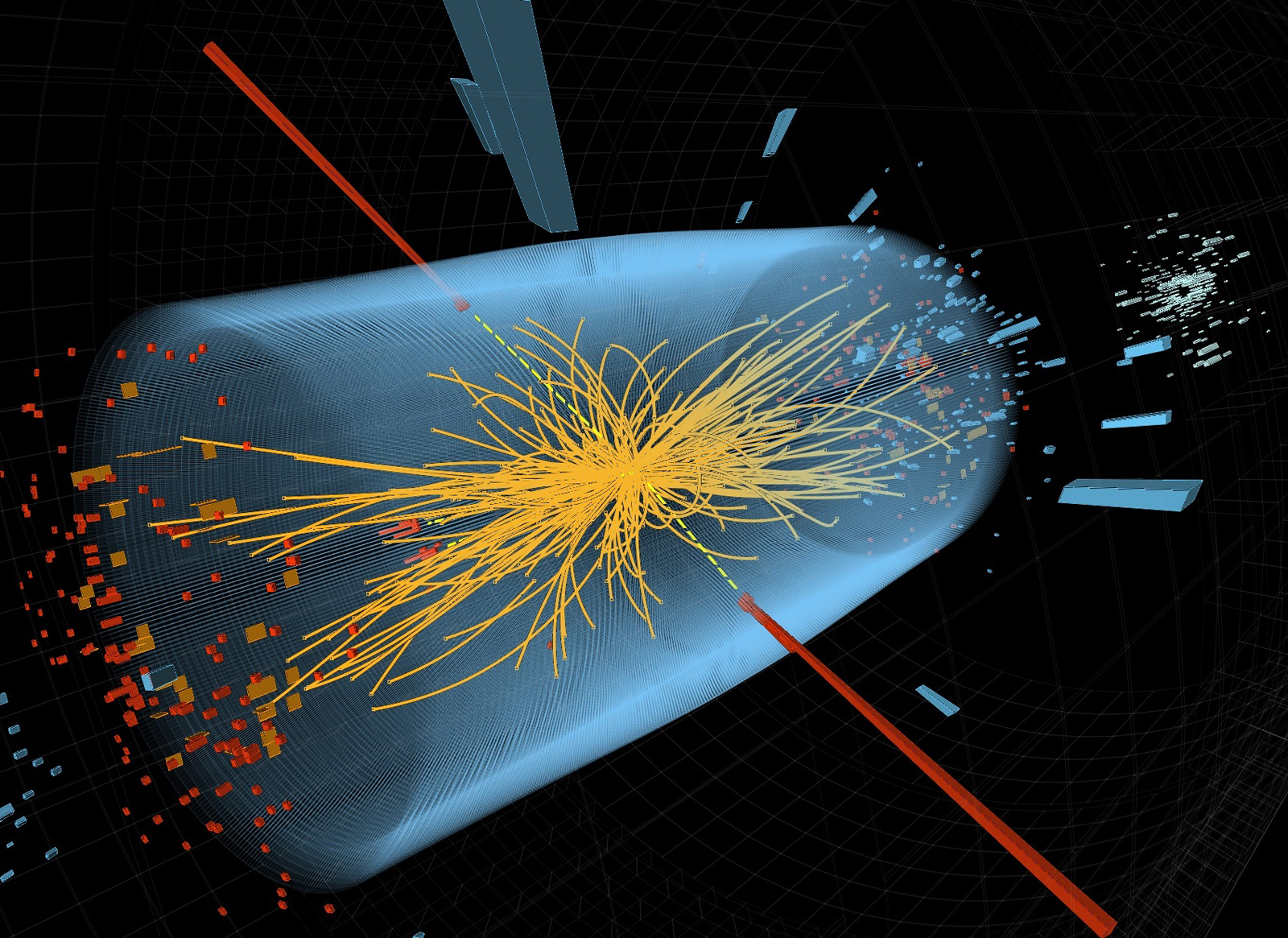Acercándonos al LHC
La Luminosidad (L) es uno de los más importantes parámetros de un acelerador.

L puede ser obtenido semicualitativamente de:
- N2 : número de protones, porque cada partícula en un paquete (bunch) puede colisionar con cualquir otra del paquete que se aproxima en sentido contrario.
- t : tiempo entre bunches.
- Sef : sección de colisión efectiva que depende de la sección del bunch. (“efectiva” porque el perfil del haz no está perfectamente definido);
Sef = 4π·σ2 con σ=16 micras o 16·10-4 cm (tamaño transversal de la sección del bunch en el punto de interacción)
Otro parámetro a ser considereda es F, el factor geométrico de reducción de la luminosidad, (≤ 1), debido al ángulo de cruce en el punto de interacción (IP). Pero, por ejemplo, en 2011 su valor alcanzó F ~ 0.95 , por lo que podemos tomarlo como 1.
Tenemos entonces:
| L ~ N2/(t·Seff ) |
Con N2 = (1,15·1011)2
t = 25·10-9 s , Seff =4·π(16·10-4)2 cm2
L ~ 1034 cm-2·s-1
Si utilizamos la frecuencia de cruce de los paquetes (f, en este caso 40·106), y tomando Seff=4·π·σ2 podemos expresar la Luminosidad en la más habitual forma:
| L ~ f·N2 /(4·π·σ2) |
Y si suponemos diferente número de protones para cada un de los dos bunches que se cruzan, y consideramos separadamente las dos componentes x e y para σ:
| L = f· N1N2 /(4πσx σy) |
También podemos expresar la Luminosidad en términos de ε (emitancia), y βeta (función de amplitude):
| L = f·N2/ (4·ε·β*) | (ver aquí) |
El valor, L= 1034 cm-2·s-1, nos dice que en los detectores do LHC se podrían producir 1034 colisións por segundo y por cm2
Dado que en el LHC el valor de L é 100 veces mayor que en el anterior LEP o en el Tevatron (EEUU), el CERN va a ser durante muchos años líder en el campo experimental de la Física de Partículas
Después de que el LHC haya operado durante algunos años con los parámetros nominales, es necesario mejorarlos para alcnzar una más alta luminosidad. La forma más directa de aumentar la luminosidade es focalizar los haces de protones más estrechamente en los puntos de colisión (reducir el valor de Sef en la fórmula, o más específicamente reducir el llamado parámetro β*) lo que implicará un rediseño de la "óptica mágnética" en las regiones de interacción (IR).
El tempo a considerar estará muy relacionado con la vida operativa de los sistemas magnéticos sometidos durante la operación do LHC a muy altas dosis de radiación. Otra reestructuración tiene que ver con la cadena de inyección de los haces y el acelerador lineal LINAC 4 sustituyo en 2022 al antiguo sistema de inyección.
Otras opciones también consideradas para incrementar la luminosidad del LHC, son el aumento del número de "bunches", o el aumento del número de protones por "bunch". No obstante,hay limitaciones en como eseo parámetros pueden ser variados, tales como el límite operativo de bunches y las llamadas interacciones haz-haz de largo rango (que se producen cerca del punto de colisión entre bunches antes del cruce), los efectos debidos a las nubes de electrones procedentes de las paredes de los tubos, implicaciones en la protección de los sistemas de colimación, o un excesivo "apilamento" de sucesos en el detector.
Todas estas acciones son realizadas fundamentalmente durante las largas paradas (LS). Ver por ejemplo LS2.
La integral de la luminosidad extendida en el tiempo se llama luminosidad integrada. Es una medida de la cantidad de datos obtenidos, siendo un importante parámetro para caracterizar a un acelerador. Nos da una medida más completa de su rendimiento permitiendo comparar diferentes aceleradores entre si.
![]()
Se mide en unidades inversas de sección eficaz (como por ejemplo: 1/nb or nb-1 - nanobarn-1 ; 1/pb or pb-1 - picobarn-1 ; 1/fb or 1fb-1 - femtobarn-1).
Nota: un femtobarn inverso (fb-1) corresponde aproximadamente a 70 billones de colisiones protón-protón.
La siguiente gráfica muestra la luminosidad integrada en los experimentos ATLAS y CMS durante diferentes LHC runs. El de 2018 produjo 65 femtobarns inversos de datos, que son 16 puntos más que en 2017. (Imagen: CERN)

La luminosidad integrada accumulado en los Runs 1 y 2 fue de 196 b-1 , y se espera llegar a 500 b-1 al final del Run 3 .
Para más información sobre la luminosidad del LHC ver aquí.
|
AUTORES Xabier Cid Vidal, Doctor en Física de Partículas (experimental) por la Universidad de Santiago (USC). Research Fellow in experimental Particle Physics en el CERN, desde enero de 2013 a diciembre de 2015. Estuvo vinculado al Depto de Física de Partículas de la USC como becario "Juan de la Cierva", "Ramon y Cajal" (Spanish Postdoctoral Senior Grants), y Profesor Contratado Doctor. Desde 2023 es Profesor Titular de Universidad en ese Departamento (ORCID). Ramon Cid Manzano, catedrático de Fïsica y Química en el IES de SAR (Santiago - España), y Profesor Asociado en el Departamento de Didáctica de Ciencias Experimentales de la Facultad de Educación de la Universidad de Santiago (España), hasta su retiro en 2020. Es Licenciado en Física, Licenciado en Química, y Doctor por la Universidad de Santiago (USC).(ORCID). |
CERN |
LHC |
NOTA IMPORTANTE
Toda la Bibliografía que ha sido consultada para esta Sección está indicada en la Sección de Referencias
© Xabier Cid Vidal & Ramon Cid - rcid@lhc-closer.es | SANTIAGO (ESPAÑA) |



